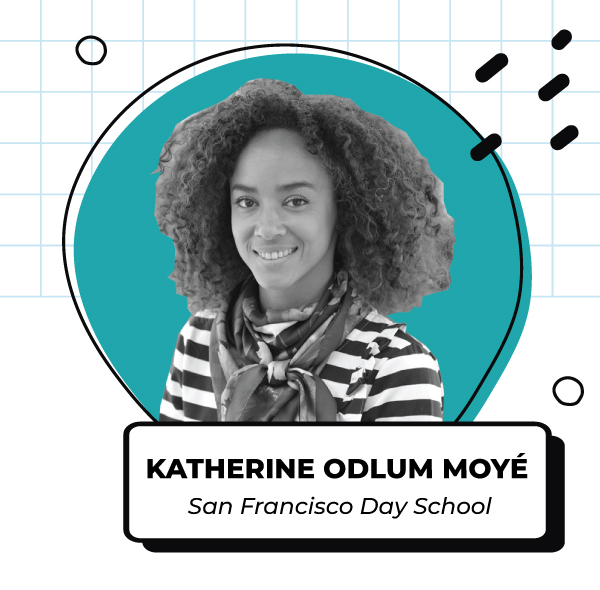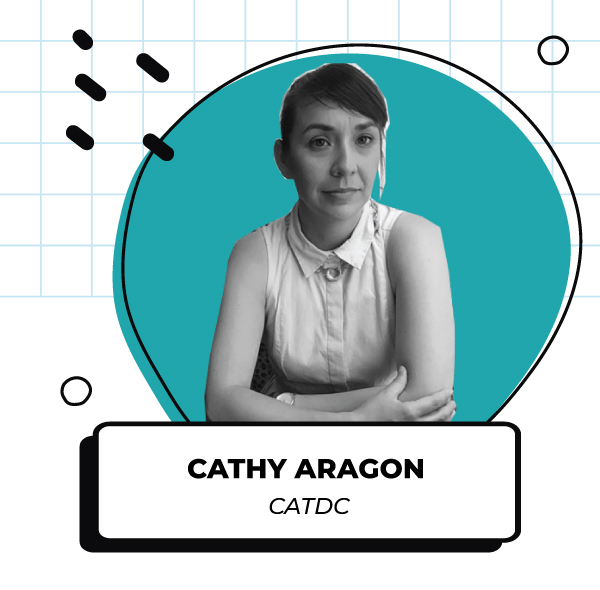COMMUNITY STORIES FOR 20 YEARS
Founded by Janet McGarvey in the early aughts as the Bay Area Teacher Development Collaborative with 58 Bay Area independent schools, the organization has expanded to Southern California and Central California and now boasts 140 member schools. Over the years CATDC has seen many changes, yet our transformational approach to professional development remains steady: whether you are a classroom teacher, an aspiring leader, or an experienced administrator, our programs provide you with the opportunity to develop to your full capacity and build sustaining relationships with peers from other schools.
Katherine Odlum Moyé and Cathy Aragon

Katherine Odlum Moyé became a first grade teacher because even though she loved learning she did not love elementary school. Katherine’s passionate about the representation of diverse ideas, identities, and their intersections for her first graders. By modeling for students how to pursue mindful, sensitive, and genuine curiosity about the things that make each of us unique she brings these values to her classroom. Katherine has worked in public, private, and charter schools for 14 years. She is originally from New York State and currently teaches first grade at San Francisco Day School. Katherine earned her BA in African American Studies and then her Masters in Education from Syracuse University.

Cathy Aragon has a passion for creating engaging and equitable learning opportunities for students and adults. She has worked in education for fifteen years in both private and public schools in San Francisco. Before joining CATDC, she worked at San Francisco Day School as a second-grade teacher and most recently as an instructional coach. She is trained in Universal Design for Learning and seeks to apply those principles to adult learning, and is currently working on her Master’s of Education with a special concentration on Equity and Social Justice from San Francisco State University. She received her multiple subject credential from the Bay Area Teacher Training Institute and holds a BA in History from Harvard University.
On a Friday morning in November 2018, the two of us, along with another colleague, made our way to Lick-Wilmerding High School for a one-day CATDC workshop, Aspiring Women Administrators of Color. The air outside was choked with smoke from the deadly Camp Fire that was raging in Paradise, CA, nearly 170 miles away. However, we were looking forward to this opportunity to learn from some of our favorite facilitators and to be in a room with other women of color who were on a similar journey. During that day together, we found opportunities to exhale and points of clarity. It was an experience that led to a deeper appreciation of ourselves, our fellow women of color educators, and clarified some questions we had about our professional careers.
Our facilitators, Lori Cohen, Shoba Farrell, Juna McDaid, and Tamisha Williams urged us to be brave in designing a vision for our own brand of leadership while acknowledging and reflecting our lived experiences as women of color in independent schools seeking more opportunities. More importantly, they modeled an authentic friendship among women, promoting collaboration over competition. They called themselves the Wolf Pack and you could see that their mutual respect, appreciation, and support ran deep. Perhaps it was this modeled friendship that inspired us. By the end of the day, it was clear that one day together wasn’t enough. We needed to get back together. The Wolf Pack worked with CATDC to host a follow-up workshop in the Spring, while several of us made plans to keep in touch. From lunch at PoCC the following month to happy hours and periodic text chains, a group of six of us former Aspiring Women Administrators of Color participants have kept in touch, to check in, provide encouragement, and share news.
In celebration of 20 years of CATDC, we got together to reflect on how that workshop continues to impact us.
On how CATDC as impacted our professional journeys
Katherine: When I lived in New York, I didn’t realize that teachers were learners. To be in the Bay Area and in independent schools, you make a commitment to be a learner. CATDC has created an authentic vehicle for being a learner within a community. And for programs like Aspiring Women of Color Administrators, to know that there are subgroups that are so specific but have a large draw, is amazing. We are experiencing intersectionality in a multitude of ways, and CATDC’s response to that is really inspiring. You get a realness, a specificity, about what is being shared.
Cathy: This workshop along with other CATDC leadership workshops I attended, presented an opportunity to have my values reflected. When I saw the way that Lori, Shoba, Juna, and Tamisha led, I thought, “I knew it! It’s possible to be a different type of leader.” Up until that point, I was made to feel naive about my ideas on leadership because I was a young leader. In the same way that new teachers are often dismissed for their beliefs: “Oh, you’ll think differently after you’ve been doing this awhile.” Just because you’re not exposed to a certain type of leadership in your day-to-day life, it doesn’t mean it can’t exist. Then here was an example of four inspiring women who were carving out their own ways of being leaders and generously showing us the way. When my current position at CATDC was posted online, it was Lori Cohen who suggested I apply. I honestly don’t think I would have seriously considered it if I hadn’t experienced the type of leadership that I was exposed to at CATDC workshops. It was like a window opened up to this different world, and I felt drawn to be a part of it. Going to these workshops presented opportunities that opened doors for me. CATDC did not just lead to new possibilities, it led to being open to those new opportunities when they present themselves.
What leadership means to us
Katherine: Leadership is finding a place from where one is positioned, no matter their role, to enable people to empower themselves to do the things that help them in their classrooms. I am growing into the phrase “collaborate & delegate” as my leadership mantra. It feels really important to connect with the folks you are working with and enable your team to work in their own ways, bringing strength to the overall project in the end. Being a leader is also about saying no and setting boundaries. I now know what I am willing to take on and what I am willing to turn down. I have become more vocal about what my possibilities are, even if the realm of possibility is small. I remember being in that room at Aspiring Women Administrators of Color and having a conversation with a fellow participant, Anjali. At the time, I was thinking of moving into instructional coaching or division head positions. Now with COVID, I have doubled-down on my classroom work and being a leader for children and peers.
Cathy: The type of leadership that I was searching for and ultimately discovered--thankfully--is about creating space for people to be honest with themselves and with members of leadership. In my mind, a strong leader creates a community where it is OK to be vulnerable. This type of leader is deeply invested in building relationships and building trust. It’s funny, Kate Sheppard, another CATDC facilitator, talks about different styles of leadership. So thanks to her, I actually have a name for the type of leadership I both aspired to emulate and craved for myself. Not only that, I learned that this type of leadership, engaging leadership according to Kate, is one of the leadership styles that is most needed in times of crisis. So, again, I wasn’t being naive in thinking this was a worthy form of leadership to pursue. The other type, which I also am drawn to and am pushing myself towards more, is a transformational leader. Together with these two styles, a leader can balance being open to and in touch with feelings while pushing their community to connect with their purpose.
On being in this affinity space
Katherine: Fear is an incredible motivator, if you recognize it, name it, face it, you can empower yourself. You can do what you are afraid to do and do it at a high level. Sitting in that room with so many women who were afraid but still doing the thing they were afraid of, it was like we were doing something scary but in a community.
Cathy: It was so inspiring to see so many women leaders and to see our trust and connections grow throughout the day. I definitely felt a little nervous at the beginning of the day, the imposter syndrome was in full effect. But once we started talking and sharing stories, it felt like a community was building. I felt accepted which was pretty incredible given the number of inspiring women in that room.

In my mind, a strong leader creates a community where it is OK to be vulnerable. This type of leader is deeply invested in building relationships and building trust.

Although COVID has made it impossible to get together, the six of us still share a bond that was seeded at Aspiring Women of Color Administrators and grew over time. Even the act of writing this piece together brought back so many memories. On that November day back in 2018, we truly were engaged in a brave act: trying to envision a future amidst a haze of uncertainty. We are still on our own respective journeys, defining new ways to lead, but also knowing we have a community to return to from time to time.
*This interview has been edited for length and clarity.
